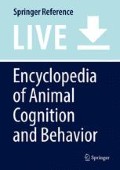References
Bicca-Marques, J. C., & Garber, P. A. (2004). Use of spatial, visual, and olfactory information during foraging in wild nocturnal and diurnal anthropoids: A field experiment comparing Aotus, Callicebus, and Saguinus. American Journal of Primatology, 62, 171–187.
Brown, C. H., & Waser, P. M. (2017). In R. M. Quam, M. A. Ramsier, R. R. Fay, & A. N. Popper (Eds.), Primate hearing and communication (pp. 79–107). Cham: Springer.
Caine, N. G., & Weldon, P. J. (1989). Sources of stress in captivity. Biotropica, 21, 186–189.
Carvalho, L. S., Pessoa, D. M. A., Mountford, J. K., Davies, W. I. L., & Hunt, D. M. (2017). The genetic and evolutionary drives behind primate color vision. Frontiers in Ecology and Evolution, 5, 34.
Caselli, C. B., Mennill, D. J., Bicca-Marques, J. C., & Setz, E. Z. F. (2014). Vocal behavior of black-fronted titi monkeys (Callicebus nigrifrons): acoustic properties and behavioral contexts of loud calls. American Journal of Primatology, 76, 788–800.
Caselli, C. B., Mennill, D. J., Gestich, C. C., Setz, E. Z. F., & Bicca-Marques, J. C. (2015). Playback responses of socially monogamous black-fronted titi monkeys to simulated solitary and paired intruders. American Journal of Primatology, 77, 1135–1142.
Costa, R. S., & Bicca-Marques, J. C. (2014). Owl monkeys (Aotus nigriceps and A. infulatus) follow routes instead of food-related cues during foraging in captivity. PLoS One, 9, e115188.
Dominy, N. J., Lucas, P. W., Osorio, D., & Yamashita, N. (2001). The sensory ecology of primate food perception. Evolutionary Anthropology, 10, 171–186.
Epple, G., Belcher, A. M., Küderling, I., Zeller, U., Scolnick, L., Greenfield, K. L., & Smith, A. B., III. (1993). In A. B. Rylands (Ed.), Marmosets and tamarins: Systematics, behaviour, and ecology (pp. 123–151). Oxford: Oxford University Press.
Garber, P. A., & Hannon, B. (1993). Modeling monkeys - a comparison of computer-generated and naturally-occurring foraging pattern in 2 species of Neotropical primates. International Journal of Primatology, 14, 827–852.
Hernández-Salazar, L. T., Dominy, N. J., & Laska, M. (2015). In M. M. Kowalewski, P. A. Garber, L. Cortés-Ortiz, B. Urbani, & D. Youlatos (Eds.), Howler monkeys: Adaptive radiation, systematics, and morphology (pp. 317–336). New York: Springer.
Heymann, E. W. (2006). Scent marking strategies of New World primates. American Journal of Primatology, 68, 650–661.
Kitchen, D. M., da Cunha, R. G. T., Holzmann, I., & de Oliveira, D. A. G. (2015). In M. M. Kowalewski, P. A. Garber, L. Cortés-Ortiz, B. Urbani, & D. Youlatos (Eds.), Howler monkeys: Adaptive radiation, systematics, and morphology (pp. 369–399). New York: Springer.
Laska, M., Alicke, T., & Hudson, R. (1996). A study of long-term odor memory in squirrel monkeys (Saimiri sciureus). Journal of Comparative Psychology, 110, 125–130.
Laska, M., Freist, P., & Krause, S. (2007). Which senses play a role in nonhuman primate food selection? A comparison between squirrel monkeys and spider monkeys. American Journal of Primatology, 69, 282–294.
Melin, A. D., Chiou, K., Walco, E., Bergstrom, M., Kawamura, S., & Fedigan, L. (2017). Trichromacy increases fruit intake rates of wild capuchins (Cebus capucinus imitator). Proceedings of the National Academy of Sciences, 114, 10402-10407.
Melin, A. D., Fedigan, L. M., Hiramatsu, C., Sendall, C. L., & Kawamura, S. (2007). Effects of colour vision phenotype on insect capture by a free-ranging population of white-faced capuchins (Cebus capucinus). Animal Behaviour, 73, 205–214.
Melin, A. D., Fedigan, L. M., Hiramatsu, C., & Kawamura, S. (2008). Polymorphic colour vision in white-faced capuchins (Cebus capucinus): Is there foraging niche divergence among phenotypes? Behavioral Ecology and Sociobiology, 62, 659–670.
Mollon, J. D., Bowmaker, J. K., & Jacobs, G. H. (1984). Variations of colour vision in a New World primate can be explained by polymorphism of retinal photopigments. Proceedings of the Biological Sciences, 222, 373–399.
Moreira, L. A. A., de Oliveira, D. G. R., de Sousa, M. B. C., & Pessoa, D. M. A. (2015). Parturition signaling by visual cues in female marmosets (Callithrix jacchus). PLoS One, 10, e0129319.
Morgan, K. N., & Tromborg, C. T. (2007). Sources of stress in captivity. Applied Animal Behaviour Science, 102, 262–302.
Nishimura, A., Fonseca, G. A. B., Mittermeier, R. A., Young, A. L., Strier, K. B., & Valle, C. M. C. (1988). In R. A. Mittermeier, A. B. Rylands, A. Coimbra-Filho, & G. A. B. Fonseca (Eds.), Ecology and behavior of neotropical primates (Vol. 2, pp. 577–610). Washington, DC: World Wildlife Fund.
Pablo-Rodríguez, M., Hernández-Salazar, L. T., Aureli, F., & Schaffner, C. M. (2015). The role of sucrose and sensory systems in fruit selection and consumption of Ateles geoffroyi in Yucatan, Mexico. Journal of Tropical Ecology, 31, 213–219.
Pessoa, D. M. A., Maia, R., Ajuz, R. C. D. A., de Moraes, P. Z. P. M. R., Spyrides, M. H. C., & Pessoa, V. F. (2014). The adaptive value of primate color vision for predator detection. American Journal of Primatology, 76, 721–729.
Snowdon, C. T. (2017). In R. M. Quam, M. A. Ramsier, R. R. Fay, & A. N. Popper (Eds.), Primate hearing and communication (pp. 141–174). Cham: Springer.
Wright, P. C. (1989). The nocturnal primate niche in the New-World. Journal of Human Evolution, 18, 635–658.
Wright, P. C. (1994). In J. F. Baer, R. E. Walker, & I. Kakoma (Eds.), Aotus: The owl monkey (pp. 97–112). San Diego: Academic.
Author information
Authors and Affiliations
Corresponding author
Editor information
Editors and Affiliations
Section Editor information
Rights and permissions
Copyright information
© 2018 Springer International Publishing AG
About this entry
Cite this entry
Bicca-Marques, J.C., Pessoa, D.M.A. (2018). Platyrrhine Sensory Systems. In: Vonk, J., Shackelford, T. (eds) Encyclopedia of Animal Cognition and Behavior. Springer, Cham. https://doi.org/10.1007/978-3-319-47829-6_1857-1
Download citation
DOI: https://doi.org/10.1007/978-3-319-47829-6_1857-1
Received:
Accepted:
Published:
Publisher Name: Springer, Cham
Print ISBN: 978-3-319-47829-6
Online ISBN: 978-3-319-47829-6
eBook Packages: Springer Reference Behavioral Science and PsychologyReference Module Humanities and Social SciencesReference Module Business, Economics and Social Sciences

